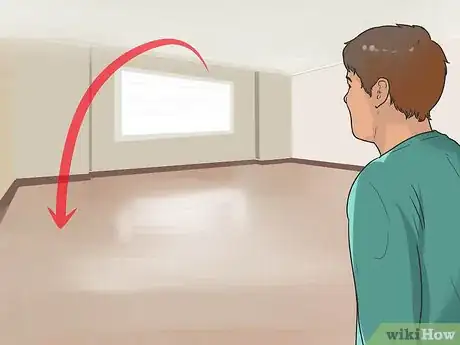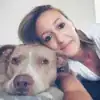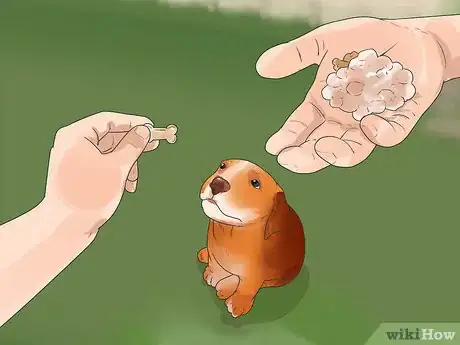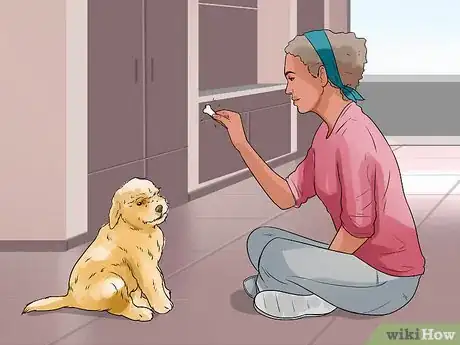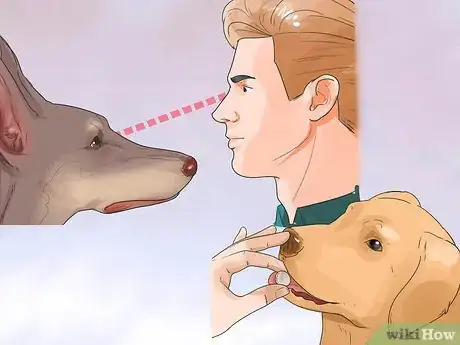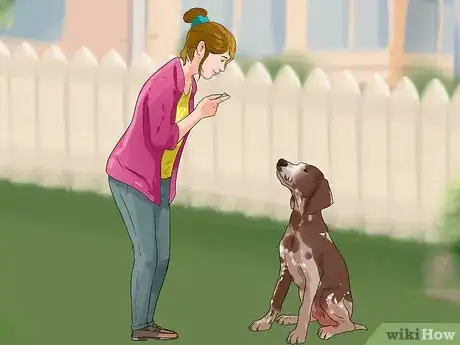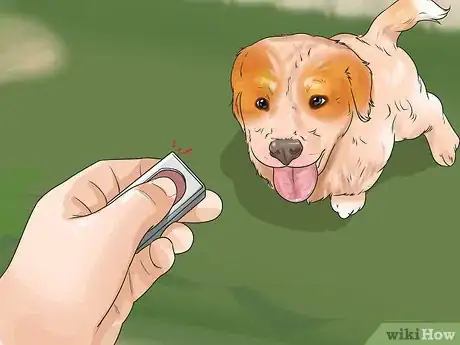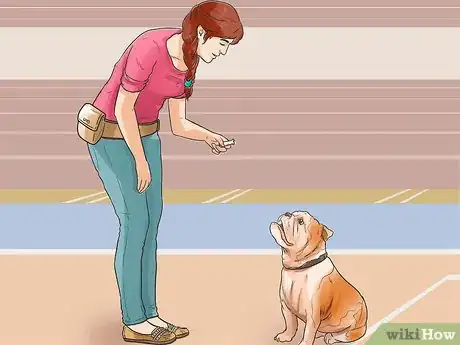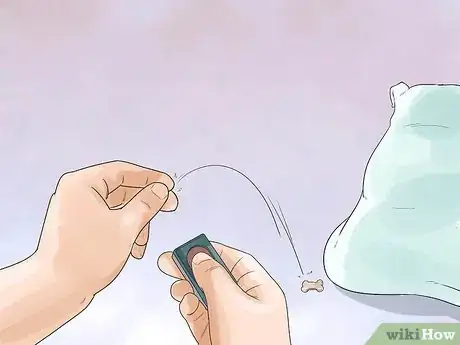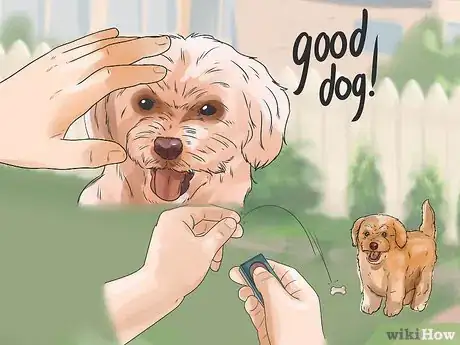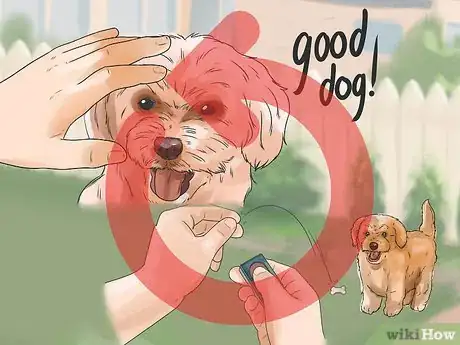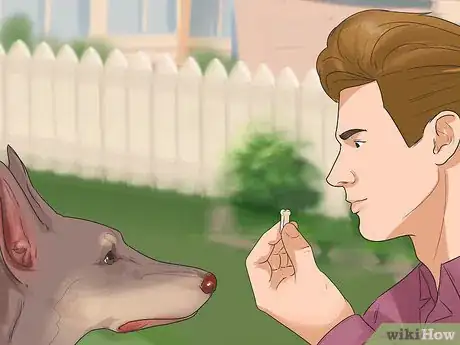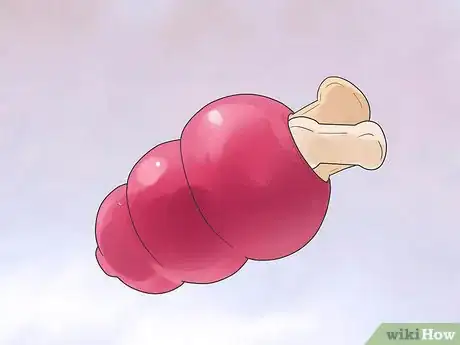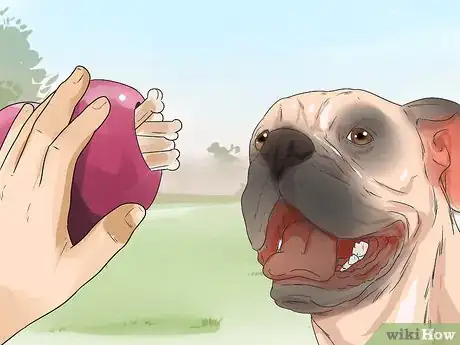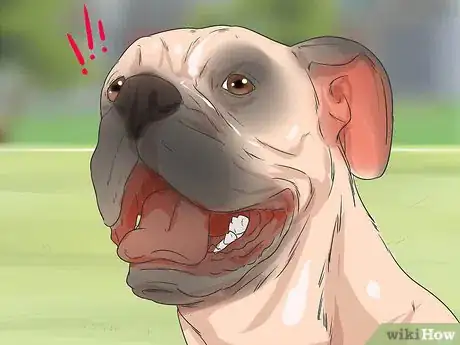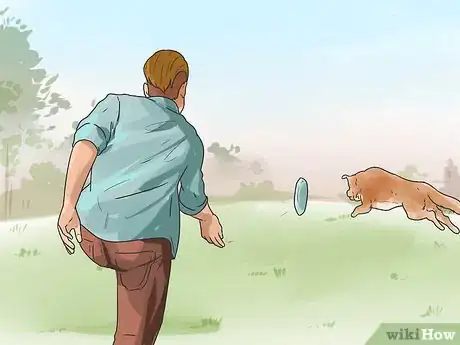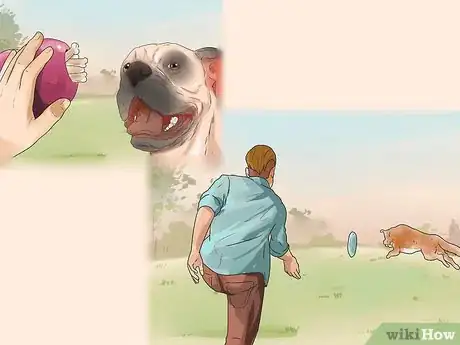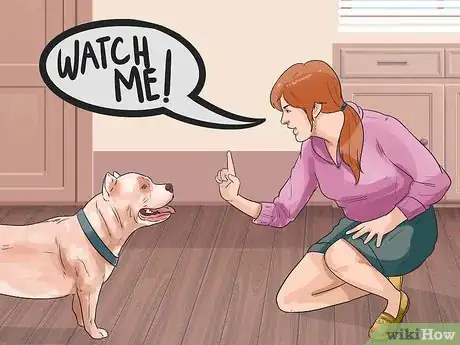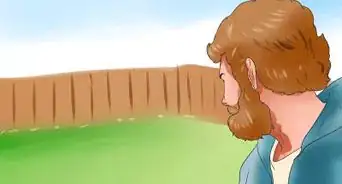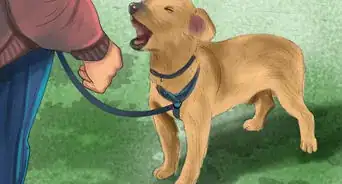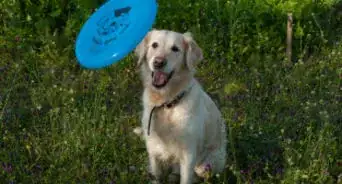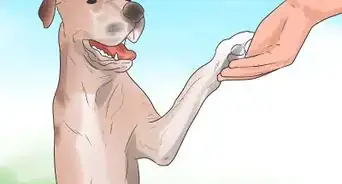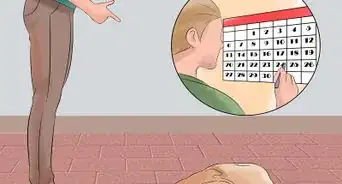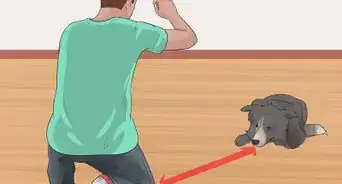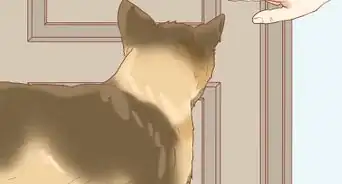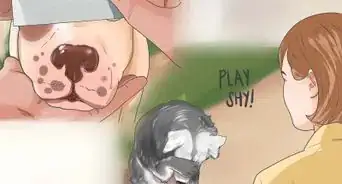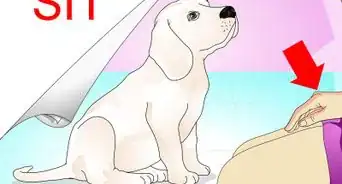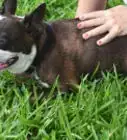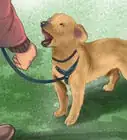This article was co-authored by Jessica Powell. Jessica is a Certified Professional Dog Trainer and the Owner of Proud Paws Dog Training, a small business offering private coaching and in-home dog training services to dog parents across the San Fernando Valley of Los Angeles, California. With nearly ten years of experience, she has extensive knowledge and experience in dog behavior, effective communication techniques, animal welfare, manners training, behavioral modification, and enrichment. Jessica holds a Bachelor of Science degree in Animal Management and is also an experienced shelter professional.
This article has been viewed 89,959 times.
In order to teach your dog new tricks, the dog should be able to focus on you. This generally means that he’ll need to maintain eye contact with you without getting distracted. Getting your dog to focus is easily taught and should be the first behaviour you teach her. It will make teaching all other tricks that much easier.
Steps
Teaching Focus Through Hand Feeding
-
1Choose the right setting. When you begin training your dog to focus, you want to start in a place with as few distractions as possible.[1] Find a place that is quiet, where you can control the circumstances during training.[2]
- An indoor space in your house may be ideal.
- Turn off devices such as phones and televisions.
- Keep children and other animals in another room so they don’t distract the dog.
-
2Hold kibble in your hand. This should be the food that your dog already knows and eats. Hold as much of the kibble in your hand as you can.[3] Offer it to the dog.[4]
- Open your hand and let him eat the food directly from your hand.
Advertisement -
3Practice the next day. Go to the same location that you trained in yesterday. Hold the handful of kibble the same way you did the day before. Wait until your dog makes eye contact with you. When he does, offer him the kibble.[5]
- Offer him the entire ration of kibble at this time.
- If the dog does not make eye contact with you on his own, you can say his name to get his attention.
- Do not open your hand to show or offer the kibble until he makes eye contact. That will defeat the training.
-
4Require longer eye contact. The next day, go to the same place, free from distractions. Hold the kibble in your hand so that he can see your hand. Wait until your dog makes eye contact with you for three entire seconds. When he does, say, “take it,” and open your hand for him to eat.[6]
- Practice this everyday. Each day, require that he maintain eye contact for a little bit longer, until he can maintain eye contact for at least eight seconds before you offer the ration of kibble.
-
5Practice in places with distractions.[7] Once the dog has mastered eye contact and focus in the calm environment, begin to practice in places with distractions. There can be other people around, or even other animals. You may want to try going outside while keeping the dog on a leash, just in case.[8]
- Do not attempt to practice in a place with distractions until the dog has mastered eye contact and focus in a controlled environment.
- Increase the amount of distractions slowly. Don’t just go from complete seclusion to a raucous dog park.
- Once your dog has mastered the behavior in a place with distractions, practice without offering him a treat. Instead, simply give him verbal praise and pet him.
Teaching Focus with a Clicker
-
1Get a training clicker.[9] Training clickers are very simple devices that you can buy from your local pet store. They make a small clicking sound that your dog will learn to associate with positive behavior.[10]
- Clickers are useful because they provide a sound that is more consistent than your own voice or vocal commands.
- Clickers are most effective when used in tandem with treats. That way, the dog will associate the clicking sound with the positive reinforcement of the treat.
-
2Put a stash of treats in your pocket or bag. They can be small, fingernail-sized treats. You can purchase these from your local pet store or grocery store. Avoid using human food as treats. It may not be healthy for your dog and may encourage begging at the table.
-
3Toss a treat behind the dog. Do this in a quiet, secluded place with no distractions or other dogs. Don’t say anything to the dog before tossing the treat. Simply show it to him, then throw it behind him.
- After the dog eats the treat, he may spend time looking for more. Stay patient and wait while he does this.
-
4Reward him when he looks back at you. Eventually, your dog will look back at you. As soon as you see him turn toward you, mark it with a click and a treat. Do this immediately so that he’ll associate the treat with the fact that he looked at you.[11]
- You can also praise the dog for performing the desired behavior.
-
5Repeat this. Toss another treat behind your dog. Again, he’ll find it and eat it, and likely search for more. Wait for him to look at you. When he does, respond immediately with a treat and a click.
- Repeat this pattern five to ten times in one sitting. By then end of the session, your dog will probably look back at you pretty quickly after finding the treat.
- Continue to practice this for a week or more depending on how long it takes your dog to master orienting toward you.
- Once your dog has mastered the behavior in a place with distractions, practice without offering him a treat or using the clicker. Instead, simply give him verbal praise and pet him.
-
6Hold the treat near your face if necessary. If your dog fails to grasp the goal of orienting toward you, try holding the treat up to your face before you give it to him. Some trainers consider this “cheating,” but it can be helpful if the dog is struggling to meet your eyes.[12]
Teaching Focus with a Toy
-
1
-
2Hold the toy so the dog can see it. You should be standing or sitting in front of the dog. Hold the toy in your hand away from your body. Keep it completely still so the dog can see it and doesn’t think you’re already playing.[15]
- In your other hand, hold a clicker. A clicker can be bought at a pet supply store for very little money. It's a tool that makes small clicking sounds to signal to the dog that he's done a good job.
- Your dog will probably focus on the toy. He may jump or bark to get you to start playing.
- Stay calm and be patient. Do not move. Don’t move the toy.
-
3Keep your focus on his face. Stand or sit totally still. Keep your eyes locked on your dog’s. Eventually he will realize that you’re not going to play and he will look you in the eyes. He may be sad or frustrated. That’s okay, you’ll play with him soon.[16]
- Your dog may act very frustrated or upset when you won’t play with him. Stay strong. You need to allow your dog to feel a little uncomfortable in order to train him.
-
4Respond positively when he looks at you. Eventually, your dog will look at you. When he does, immediately mark that moment with a clicker. Then give him the toy or throw it for him to go fetch.[17]
- Be sure to respond immediately to the desired behavior so that your dog will associate it with positive feedback.
-
5Practice this game many times. Keep playing this game with your dog until his attention wears thin. He will eventually begin to look at you very quickly when he realizes that looking at you gets him what he wants.[18]
- Dogs have different attention spans. If your dog seems tired or disinterested, rest for the day and play again tomorrow.
- Keep your method and reward consistent until your dog has mastered the art of focusing.
-
6
Expert Q&A
-
QuestionHow can I improve my dog's focus?
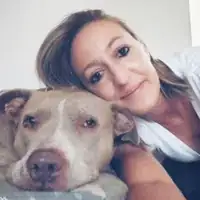 Jessica PowellJessica is a Certified Professional Dog Trainer and the Owner of Proud Paws Dog Training, a small business offering private coaching and in-home dog training services to dog parents across the San Fernando Valley of Los Angeles, California. With nearly ten years of experience, she has extensive knowledge and experience in dog behavior, effective communication techniques, animal welfare, manners training, behavioral modification, and enrichment. Jessica holds a Bachelor of Science degree in Animal Management and is also an experienced shelter professional.
Jessica PowellJessica is a Certified Professional Dog Trainer and the Owner of Proud Paws Dog Training, a small business offering private coaching and in-home dog training services to dog parents across the San Fernando Valley of Los Angeles, California. With nearly ten years of experience, she has extensive knowledge and experience in dog behavior, effective communication techniques, animal welfare, manners training, behavioral modification, and enrichment. Jessica holds a Bachelor of Science degree in Animal Management and is also an experienced shelter professional.
Certified Professional Dog Trainer Start training the dog in a quiet place without distractions. It’s generally the environment that causes a dog to become distracted during training, and sometimes the distraction is simply something more exciting or meaningful to them than what the human is offering at that particular moment.
Start training the dog in a quiet place without distractions. It’s generally the environment that causes a dog to become distracted during training, and sometimes the distraction is simply something more exciting or meaningful to them than what the human is offering at that particular moment. -
QuestionHow do you get a dog's attention when training?
 Jessica PowellJessica is a Certified Professional Dog Trainer and the Owner of Proud Paws Dog Training, a small business offering private coaching and in-home dog training services to dog parents across the San Fernando Valley of Los Angeles, California. With nearly ten years of experience, she has extensive knowledge and experience in dog behavior, effective communication techniques, animal welfare, manners training, behavioral modification, and enrichment. Jessica holds a Bachelor of Science degree in Animal Management and is also an experienced shelter professional.
Jessica PowellJessica is a Certified Professional Dog Trainer and the Owner of Proud Paws Dog Training, a small business offering private coaching and in-home dog training services to dog parents across the San Fernando Valley of Los Angeles, California. With nearly ten years of experience, she has extensive knowledge and experience in dog behavior, effective communication techniques, animal welfare, manners training, behavioral modification, and enrichment. Jessica holds a Bachelor of Science degree in Animal Management and is also an experienced shelter professional.
Certified Professional Dog Trainer You can use yummier food rewards, or more exciting toys and body language to keep them interested in you in more challenging situations.
You can use yummier food rewards, or more exciting toys and body language to keep them interested in you in more challenging situations. -
QuestionHow do I stop my dog from getting distracted?
 Jessica PowellJessica is a Certified Professional Dog Trainer and the Owner of Proud Paws Dog Training, a small business offering private coaching and in-home dog training services to dog parents across the San Fernando Valley of Los Angeles, California. With nearly ten years of experience, she has extensive knowledge and experience in dog behavior, effective communication techniques, animal welfare, manners training, behavioral modification, and enrichment. Jessica holds a Bachelor of Science degree in Animal Management and is also an experienced shelter professional.
Jessica PowellJessica is a Certified Professional Dog Trainer and the Owner of Proud Paws Dog Training, a small business offering private coaching and in-home dog training services to dog parents across the San Fernando Valley of Los Angeles, California. With nearly ten years of experience, she has extensive knowledge and experience in dog behavior, effective communication techniques, animal welfare, manners training, behavioral modification, and enrichment. Jessica holds a Bachelor of Science degree in Animal Management and is also an experienced shelter professional.
Certified Professional Dog Trainer Follow the tips above, but remember that it’s also possible that your dog isn’t distracted but is just tired, thirsty, uncomfortable, or has reached their limit for learning at that particular moment, so make sure to give them plenty of breaks and end on a positive note.
Follow the tips above, but remember that it’s also possible that your dog isn’t distracted but is just tired, thirsty, uncomfortable, or has reached their limit for learning at that particular moment, so make sure to give them plenty of breaks and end on a positive note.
Things You'll Need
- A dog
- A clicker
- Dog treats
- Dog toys
- A leash
References
- ↑ Jessica Powell. Certified Professional Dog Trainer. Expert Interview. 5 October 2021.
- ↑ http://www.greenacreskennel.com/dog-behavior-and-training/attention-look-watch-me.html
- ↑ Jessica Powell. Certified Professional Dog Trainer. Expert Interview. 5 October 2021.
- ↑ http://www.greenacreskennel.com/dog-behavior-and-training/attention-look-watch-me.html
- ↑ http://www.greenacreskennel.com/dog-behavior-and-training/attention-look-watch-me.html
- ↑ http://www.greenacreskennel.com/dog-behavior-and-training/attention-look-watch-me.html
- ↑ Jessica Powell. Certified Professional Dog Trainer. Expert Interview. 5 October 2021.
- ↑ http://www.greenacreskennel.com/dog-behavior-and-training/attention-look-watch-me.html
- ↑ Jessica Powell. Certified Professional Dog Trainer. Expert Interview. 5 October 2021.
- ↑ http://www.puppyleaks.com/clicker-training-dog-basics/
- ↑ http://www.puppyleaks.com/clicker-training-dog-basics/
- ↑ http://www.loveyourdog.com/watch.html
- ↑ Jessica Powell. Certified Professional Dog Trainer. Expert Interview. 5 October 2021.
- ↑ http://www.thedogtrainingsecret.com/blog/teaching-dog-drive-eye-contact-focus-leash-skills/
- ↑ http://www.thedogtrainingsecret.com/blog/teaching-dog-drive-eye-contact-focus-leash-skills/
- ↑ http://www.thedogtrainingsecret.com/blog/teaching-dog-drive-eye-contact-focus-leash-skills/
- ↑ http://www.thedogtrainingsecret.com/blog/teaching-dog-drive-eye-contact-focus-leash-skills/
- ↑ http://www.thedogtrainingsecret.com/blog/teaching-dog-drive-eye-contact-focus-leash-skills/
- ↑ Jessica Powell. Certified Professional Dog Trainer. Expert Interview. 5 October 2021.
- ↑ http://www.thedogtrainingsecret.com/blog/teaching-dog-drive-eye-contact-focus-leash-skills/
About This Article
To teach your dog to focus, start by finding a quiet place without distractions for your training sessions. During the first session, hold some dog food in your hand and let your dog eat it directly from your hand. For the next session, return to the same place, but wait for your dog to make eye contact with you before you let it eat the food. Then, increase the amount of time you require your dog to make eye contact before rewarding it with food. For tips from our Veterinary co-author on how to teach your dog to focus using its favorite toy, read on!
